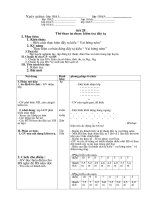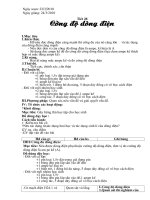Tài liệu Lecture 28: Trunks and Multiplexing: pptx
Bạn đang xem bản rút gọn của tài liệu. Xem và tải ngay bản đầy đủ của tài liệu tại đây (91.71 KB, 7 trang )
CSN200 Introduction to Telecommunications, Winter 2000 Lecture-28 Multiplexing
Trunks and Multiplexing:
What happens, when there is only one media available between two local offices, as shown below?
Local
Office
Local
Office
℡
℡
℡
℡
℡
℡
℡
℡
℡
℡
In this case the media is the space and the link between the two local offices is the Microwave link.
The users from the left want to communicate the users on the right. They have to share the common
media. This can be done in two ways:
First, the users can take turns; each one periodically uses the microwave link for a short period of time.
This time-sharing is known as Time division Multiplexing (TDM).
Second, the bandwidth of the microwave link can be divided among logical channels, with each user
having exclusive possession of some frequency band. Think the microwave link as a wide road. The
road is then divided into lanes and then each car is using their own lane. This sharing by frequency
band is known as Frequency division Multiplexing (FDM).
• Sharing one media by multiple users is known as multiplexing.
If the number of users are high then in the TDM each users have to wait for a long time to get their
turn and is not a very practical way of sharing the media. So, FDM is a better way of sharing the
media.
You could ask, why we are not establishing the same number of microwave links as the users. But are
limited by the one media. The other microwave links have to use different frequency bands, again an
example of FDM by the links.
This problem of one media can be solved by using multiple copper cables or fiber optic strands. This is
again impractical in terms of costs.
Lecture28.doc Page 1 (7)
CSN200 Introduction to Telecommunications, Winter 2000 Lecture-28 Multiplexing
This problem of one media can be solved by transmitting copper cables or fiber optic strands. All these
media have their band limitation, copper have the lowest. So we need lots of links and this is again
impractical in terms of costs and some time impossible to lay the cables.
Multiplexing:
Multiplexing is a technique employed in many different situations where different signals have to
share a medium, circuit or channel. It enables more efficient use of circuits or facilities.
A Multiplexer is a device that combines several simultaneous low speed circuits on one higher speed
circuit in such a way that each low speed circuit believes it has a separate connection to the host.
• Multiplexing voice telephone calls means two or more conversations are sent simultaneously over
one circuit.
• Multiplexing data means two or more messages are simultaneously sent over one circuit.
• Multiplexers must be transparent; that is, have no effect on the end users connection compared to
if they had their own separate connection.
• Multiplexed circuits generally have to have the same capacity (bandwidth) as the sum of the
circuits it combines.
Combining the signals from four 9600 bps terminals into one signal of 38,400 bps.
Combining 24 digital voice channels (64,000 bps) into one 1,544,000 bps (T-1) circuit.
Combining 672 digital voice channels into one 44,373,000 bps (T-3) circuit.
• A Demultiplexer does the opposite of a multiplexer; it separates a multiplexed signal back into its
separate signals, for distribution to multiple users.
Types of Multiplexers:
1. FDM Frequency Division Multiplexing
2. TDM Time Division Multiplexing
Frequency Division Multiplexing: (Chapter-3)
• FDM is an analog technique where each signal or device is allocated a separate range of
frequencies to use on the channel.
• This is similar to AM radio, for example, where each radio station transmits its signal on a different
carrier frequency (the allocated spectrum is 1100KHz, from 550KHz to 1650KHz, and that can
accommodate 1100KHz/10KHz = 110 channels).
Lecture28.doc Page 2 (7)
CSN200 Introduction to Telecommunications, Winter 2000 Lecture-28 Multiplexing
ƒ
V
ƒ
V
ƒ
V
ƒ kHz
V
100 104
ƒ kHz
V
104 108
V
108 112
ƒ kHz
V
100 104 108 112
ƒ kHz
0 4
kHz
• The signals are all present on the medium at the same time but they don’t interfere with each other
because each one is modulated onto a different carrier frequency.
• This FDM technique is less efficient, requires more maintenance and is less flexible than TDM.
• The FDM schemes used around the world are to some degree standardized.
• Group - 12 voice channels multiplexed together (12x4 kHz = 48 kHz Bandwidth)
• Supergroup - 5 groups multiplexed together (5x48 kHz = 240 kHz Bandwidth)
• Mastergroup - 10 supergroups multiplexed together (10x240 kHz = 2400 kHz Bandwidth)
• Other standards also exists - up to 230000 voice channels together (4x230000 = 920000 kHz
Bandwidth)
Time Division Multiplexing: (Chapter-3)
Time Division Multiplexing is used by the digital system where as FDM is used by the analogue
system.
In TDM one character is taken from each terminal in turn and transmitted down the circuit.
The analog signals are digitized in the end office by a device called a codec (coder-decoder). The
codec makes 8000 samples per second because Nyquist theorem says that this is sufficient to
Lecture28.doc Page 3 (7)
CSN200 Introduction to Telecommunications, Winter 2000 Lecture-28 Multiplexing
reproduce the original information back (4 kHz voice signal).
The sampling rate should be at least double the frequency of the signal being sampled.
• TDM is a digital technique in which different digital signals take turns using the available channel.
• Each signal uses the entire bandwidth for a short time and then waits for its turn again.
• Data from different signals is interleaved; each signal having its own timeslot, much like boxcars on
a train where each car carries freight for one user. The difference is that the sequence of boxcars
repeats itself endlessly.
• TDM generally more efficient than FDM, because it does not need guard bands. Guard bands could
be used to transmit data.
• TDM systems may waste bandwidth if all time slots are not unused.
North America’s T Carrier Digital Circuits form an interconnected synchronous digital
communications system of leased circuits using Time Division Multiplexing.
T Carrier
Circuit
Voice
Channels
Speed(bits/second) Equivalent
T-1 Circuit
T-1 24 1,544,000 1
T-2 48 6,312,000 4
T-3 672 44,376,000 28
T-4 4,032 274,176,000 168
Lecture28.doc Page 4 (7)
CSN200 Introduction to Telecommunications, Winter 2000 Lecture-28 Multiplexing
Time division multiplexing allows multiple T1 carriers to be multiplexed into higher-order carriers.
Fig.2-28, Tanenbaum.
FDM TDM
ƒ kHz
V
100 104 108 112
FDM
V
ƒ kHz
112
TDM
100 104 108
Lecture28.doc Page 5 (7)









